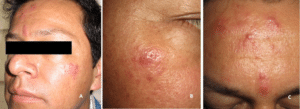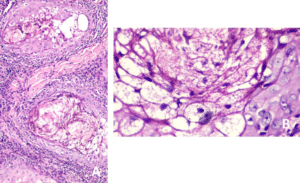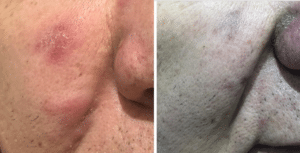Eduardo Garzón Aldás1*, Xavier Garzón Garzón2
1Dermatologist, Dermatopahologist Clinica Dermatologica Garzon, Ecuador
2Medical Resident, Clinica Dermatologica Garzon, Ecuador
*Correspondence author: Eduardo Garzón Aldás, Dermatologist, Dermatopahologist Clinica Dermatologica Garzon, Ecuador; Email: [email protected]
Published Date: 27-06-2023
Copyright© 2023 by Garzon Aldas E, et al. All rights reserved. This is an open access article distributed under the terms of the Creative Commons Attribution License, which permits unrestricted use, distribution, and reproduction in any medium, provided the original author and source are credited.
Abstract
Neutrophilic Sebaceous Adenitis (NSA) is a rare disorder of unknown cause, characterized by circinate plaques on the face and histologically by neutrophilic inflammation of the sebaceous glands accompanied by necrotic sebocytes, together with a superficial and deep perivascular infiltrated composed mainly of lymphocytes. Even though there are few cases reported of NSA, in this paper we present two new cases with optimal response to dapsone.
Keywords: Neutrophilic Sebaceous Adenitis; Face; Sebaceous Glands; Dapsone
Introduction
NSA was initially described in humans by Renfro, et al., in 1993, as a sebaceous gland disorder on the face. Clinically, the authors described an eruption of annular erythematous plaques with elevated borders [1]. Histologically there was an inflammatory infiltrate consisting of neutrophilic aggregates in the sebaceous lobules [1]. Additionally, the number of neutrophils depended on the time of evolution, therefore, lymphohistiocytic infiltrates with variable numbers of neutrophils were also seen in evolved lesions as well as scattered necrotic sebocytes [2]. The mechanism of NSA is still uncertain. This disease is considered as a photodermatosis due to a case report in Spain, with seasonal recurrences after sun exposure [3]. A study published on the journal of veterinary dermatology on dogs showed an analogous disease, responsive only to cyclosporine and steroids, leading some to speculate an autoimmune etiology [4]. Thanks to a few cases of vulval sebaceous adenitis, which developed during the luteal phase of the menstrual cycle, the idea of a possible hormonal correlation was taken into consideration [5,6]. Multiple treatments which had been previously reported on the literature including topical corticosteroids, oral antibiotics, anti-fungal isotretinoin and oral dapsone showed variable or ineffective therapeutic results [1,7-10]. Taking into consideration the fact that the disease previously mentioned is extremely rare and only a few similar cases have been reported, in this article we attempt to present two new cases of facial NSA with optimal response to oral dapsone.
Case Report
Case 1
A 38-year-old white man presented an eruption of asymptomatic erythematous plaques with satellite papules on bilateral cheeks for 8 months, with recurrent behavior. He went to other dermatologists and was diagnosed with Acne/Rosacea, Demodex infestation and then received 3 months of oral metronidazole and other topical creams with clindamycin, adapalene, but the facial lesions still persisted. There was no history of recent illness, medication, or environmental exposures. The patient had no personal or family pathological history. Physical examination demonstrated a bilateral dermatosis over his cheeks characterized by erythematous, indurate and annular plaques without any superficial scale as well as satellite papules; his forehead and glabellar zone had the same lesions (Fig. 1). Laboratory work-up was performed with normal or negative results like: normal hematic biometry, negative HIV, normal autoimmune studies, normal chest Rx.
A punch biopsy was also performed and revealed the following findings: dense perisebaceous infiltrates of lymphocytes, histiocytes and neutrophils, with little to none of them existing within the glands with scattered necrotic sebocytes in the sebaceous lobules which preserved their architecture and the basal layer of sebaceous glands appeared intact without any damage by neutrophils.

Figure 1: A,B,C; A: Erythematous, indurated circinate plaques with elevated borders on the left cheek and forehead; B: Bilateral compromise on right cheek; C: plaque and satelital papules on forehead.
With this clinical-pathology correlation we conclude in the diagnosis of NSA. The patient was started on oral dapsone therapy with 100 mg daily with great improvement within 3 weeks, he was taking the medication for 12 weeks with a progressive decrease in the dose.
Case 2
A 70-year-old white man presented an eruption of recurrent, pruritic erythematous plaques on his right cheek for 6 months. There was no history of recent illness, medication, or environmental exposures. Patient had no personal or family pathological history. Physical examination demonstrated a unilateral dermatosis over his right cheek characterized by erythematous, indurate, plaques with superficial scale (Fig. 3). Tests were carried out in the laboratory and revealed normal or negative results like: normal hematic biometry, negative HIV, normal autoimmune studies, normal chest Rx.
A punch biopsy was performed and revealed the same features of biopsy in case 1, but without infundibullar demodex and with more sebocyte necrosis (Fig. 4).
With the diagnosis of NSA the patient was started on oral dapsone therapy with 100 mg daily with great improvement within 5 weeks (Fig. 5). He kept on taking the medication for 12 weeks with a progressive decrease in the dose.

Figure 2: A,B,C,D; A: H-E 4x. Lymphohistiocytic and neutrophilic aggregation around the sebaceous glands; B: H-E 10x Demodex folliculorum mites within follicular infundibulae; C: H-E 10 X dense amount of lymphocytes, histiocytes and neutrophils surrounding the sebaceous glands with little infiltration (migration) through the lobules; D: H-E 40x The basal layer of sebaceous glands appeared intact without damage by inflammatory cells.

Figure 3: A,B; A: Unilateral distribution on right cheek; B: indurated, erythematous plaques with overlying scale.

Figure 4: A,B; A: H-E 10x perisebaceous inflammatory infiltrate composed by many neutrophils and lymphocytes; B: H-E 40 x Sebaceous gland with necrotic sebocytes.

Figure 5: Great improvement with oral dapsone, you can see before and after.
Discussion
NSA is an uncommon disorder of unknown causes. In 1993, Renfro, et al., described a patient with circinate plaques on the face characterized histologically by neutrophilic inflammation of the sebaceous glands accompanied by necrotic sebocytes, together with a superficial and deep perivascular infiltrate composed mainly of lymphocytes [1]. Since then, only 8 other cases of NSA have been published. Until 2015, four cases had been reported in a paper of the American Journal of Dermatopathology, in this article Liaqat, et al., presented a comparison chart in which they summarized the features of the 4 patients studied up to that time [2]. One year later, Tohyama M, et al., reported the first two cases of vulval sebaceous adenitis and now in 2023, two new cases were reported, one by Yoshizahi A, et al., with successful treatment with dapsone and one by Chikeka, et al., if taken into consideration, the two cases presented in this paper would be the ninth and tenth cases of NSA documented in the world dermatology literature [3-8].
The pathogenic workings of NSA are still unknown [8]. NSA is considered as a photodermatosis due to a case report in Spain, with seasonal recurrences after sun exposure [3]. Treatment with hydroxychloroquine, topical steroids and sun protection lead to the resolution of lesions, suggesting sun exposure as the underlying etiology of disease [9]. In our patients there was no relationship with sun exposure or signs of actinic damage, but both had a 2-3 skin phototype. The successful response to cyclosporine in dogs with this pathology, determined the possible role of autoimmunity [4].
Hongcharu, et al., studied the effect on the skin of the topical use of 5-aminolevulinic acid Photodynamic Therapy (PDT) for the treatment of acne vulgaris using serial skin biopsies [10]. A single treatment with PDT resulted in an immediate mixed, neutrophil-predominant infiltrate along pilosebaceous units and in perivascular areas, with retiform degeneration of sebocytes [10]. These histologic findings are similar to those of NSA, except that in NSA there is exclusive involvement of the sebaceous gland, sparing the remainder of the hair follicle. The author therefore considers this to be further support for the idea that this disorder is in fact a photodermatosis, though confirmation will require many new cases [3,9,10].
Demodex mites are a common incidental finding in many skin specimens, (like in my first patient) with the incidence of infestation increasing with age [2]. Although, often seen in normal follicles, a pathogenic role has been implicated in a number of skin conditions where Demodex mites are found in greater numbers (demodicosis) [2,10]. Two Demodex mite species are known to occupy pilosebaceous follicles in humans [2]. Demodex folliculorum lives in groups of individuals above the level of the sebaceous glands and Demodex brevis lives a solitary life deep within the sebaceous glands [2]. Demodex folliculorum is most commonly found on the face with an overall prevalence of 30% of follicles infested, 10 whereas D. brevis is less common on the face, but interestingly, men have a 2.5-fold greater incidence of D. brevis than women and NSA is more frequent in men, for that reason it’s necessary to develop more studies to determine the possible pathogenic role of these mites [2,10].
NSA is manifested as recurrent, chronic, annular, indurated and erythematous plaques with elevated borders of the face of adult men (18-72 years old) [1,3,5]. There is only one case reported in woman, compromising her neck and chest [11]. In my first case, other feature was satellite papules. Similar lesions on vulvar zone had been reported. 5,6 The lesions are asymptomatic and there are no other cutaneous or systemic signals [8,9].
We think that the clinical differential diagnosis should be made with many facial conditions, all of them have chronic or recurrent erythematous indurated discoid or annular plaques such as: Follicular mucinosis, Eosinophilic Facial Granuloma, Eosinophilic transitory Nodulosis, Eosinophilic Folicullitis, Sarcoidosis, Discoid Lupus, Lupus Vulgar, Facial Discoid Dermatosis, Bromoderma/Iododerma and with other more frequent dermatosis which have facial erythematosus papules like: acne, rosacea and demodiciosis [2,8,9,11].
Histopathology shows neutrophilic aggregates in the sebaceous lobules and scattered necrotic sebocytes [1,2]. Neutrophils may be absent in the late stage and lymphohistiocytic cells may surround the perisebaceous epithelium [2]. The more important feature for diagnosis is that inflammation is entirely located on sebaceous glands, not involving the hair follicle as would be expected in folliculitis of any etiology [2,6,9]. With these features we think that the clue for diagnosis is the clinic-pathological correlation facial dermatosis with chronic or recurrent behavior, characterized by annular, indurated, erythematous plaques and histological signs of adenitis (perisebaceous infiltrate of neutrophils and lymphocytes). Different treatments have been reported with variable results. Starting with topical corticosteroids, which led to partial clearing and later recurrence [1]. Oral antibiotic 7 and anti-fungal, 10 tetracycline and griseofulvin, 5 were ineffective. Systemic steroid therapy had short term results [3]. Long term remission after oral isotretinoin treatment had been reported due to the sebostatic effects of isotretinoin in human sebaceous cells resulting in shrinkage of the sebaceous glands and secondary to inhibition of differentiation of mature sebocytes just like induction of apoptosis and cell cycle arrest and the anti-inflammatory effects of this drug [7]. Oral dapsone showed positive results [8].
We decided to treat these patients with the last medication, because dapsone has a very strong neutrophil antichemotactic activity and the NSA is a neutrophilic dermatosis, resulting in both patients having notoriously improved [8]. We don’t use immunosuppressants like cyclosporin, azathioprin or JAK inhibitors because they are more expensive, don´t have a direct effect against neutrophils and are drugs thar require great control compared to dapsone. Finally, most of these drugs are not for sale in our country, for example, topical JAK inhibitors. It’s important to emphasize that we chose dapsone as our first line of treatment and no other options like topical ivermectin despite the discoveries on Demodex on account of the fact that demodex folliculorum mites are a common incidental finding in many skin biopsy specimens, without any cutaneous symptoms and also Demodex brevis, habitant of the sebaceous glands and not in the infundibulae is the one that could have a pathogenic effect in NSA [2]. In both of these cases, we didn’t find any demodex in sebaceous glands; lastly, the patient number 1 previously used treatment against demodex (metronidazole) without improvement as stated in his anamnesis.
Further study is obviously required to determine the cause and best treatment of this rare entity and to identify the role of any external factors (sun light), or any mechanism of Demodex for example [2,3,9,10].
Conflict of Interest
The authors have no conflict of interest to declare.
References
- Renfro L, Kopf AW, Gutterman A, Gottlieb GF, Jacobson M. Neutrophilic sebaceous adenitis. Arch Dermatol. 1993;129:910-1.
- Liaqat M, Wilson LH, Wada D, Florell SR, Bowen AR. Neutrophilic sebaceous adenitis with intralobular Demodex mites: a case report and review of the literature. Am J Dermatopathol. 2015;37(4):315-8.
- Sanz Trelles A, Gómez Moyano E. A new case of neutrophilic sebaceous adenitis: A photodermatosis? J Am Acad Dermatol. 2009;60(5):887-8.
- Frazer MM, Schick AE, Lewis TP, Jazic E. Sebaceous adenitis in Havanese dogs: a retrospective study of the clinical presentation and incidence. Vet Dermatol. 2011;22:267-74.
- Ram-Wolff C, Halabi-Tawil M, Vignon-Pennamen MD, Bagot M, Petit A. Neutrophilic sebaceous adenitis in a woman. Ann Dermatol Venereol. 2013;140(11):708-12.
- Tohyama M, Matsumoto K, Sayama K. Two cases of genital neutrophilic sebaceous adenitis. J Dermatol. 2016;43(10):1221-3.
- Chou WT, Tsai TF, Ko WC, Hung CM, Chen YF. Neutrophilic sebaceous adenitis responsive to oral isotretinoin. Dermatologica Sinica. 2013;2(31):102-3.
- Yoshizaki A, Fujii K, Kanekura T. Neutrophilic sebaceous adenitis treated successfully with diaminodiphenyl sulfone. J Dermatol. 2023.
- Chikeka I, Kazlouskaya M, Kazlouskaya V. An unusual rash provoked by light. Int J Dermatol. 2023;62(5):e304-5.
- Hongcharu W, Taylor CR, Chang Y, Aghassi D, Suthamjariya K, Anderson RR. Topical ALA- photodynamic therapy for the treatment of acne vulgaris. J Invest Dermatol. 2000;115:183-92.
- Cunningham M, Rogers R, Greene L. Annular plaques with raised erythematous-violaceous borders on the face and torso. JAMA Dermatol. 2014;150(11):1225-6.
Article Type
Case Report
Publication History
Received Date: 03-06-2023
Accepted Date: 20-06-2023
Published Date: 27-06-2023
Copyright© 2023 by Garzon Aldas E, et al. All rights reserved. This is an open access article distributed under the terms of the Creative Commons Attribution License, which permits unrestricted use, distribution, and reproduction in any medium, provided the original author and source are credited.
Citation: Garzon Aldas E, et al. Neutrophilic Sebaceous Adenitis A Challenger Diagnosis with Favorable Response to Dapsone, Contribution of Two News Cases. J Dermatol Res. 2023;4(2):1-6.

Figure 1: A,B,C; A: Erythematous, indurated circinate plaques with elevated borders on the left cheek and forehead; B: Bilateral compromise on right cheek; C: plaque and satelital papules on forehead.

Figure 2: A,B,C,D; A: H-E 4x. Lymphohistiocytic and neutrophilic aggregation around the sebaceous glands; B: H-E 10x Demodex folliculorum mites within follicular infundibulae; C: H-E 10 X dense amount of lymphocytes, histiocytes and neutrophils surrounding the sebaceous glands with little infiltration (migration) through the lobules; D: H-E 40x The basal layer of sebaceous glands appeared intact without damage by inflammatory cells.

Figure 3: A,B; A: Unilateral distribution on right cheek; B: indurated, erythematous plaques with overlying scale.

Figure 4: A,B; A: H-E 10x perisebaceous inflammatory infiltrate composed by many neutrophils and lymphocytes; B: H-E 40 x Sebaceous gland with necrotic sebocytes.

Figure 5: Great improvement with oral dapsone, you can see before and after.


